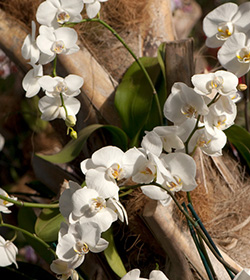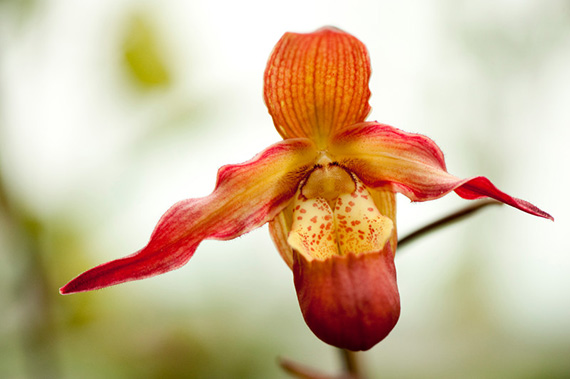Houseplants 101
Posted in Gardening Tips on January 20 2015, by Sonia Uyterhoeven
Sonia Uyterhoeven is NYBG‘s Gardener for Public Education.

The weather has grown cold and we’re well into the season of staying indoors. During this time of year, I often look around my apartment at the few forlorn houseplants (I have horrible light) and wish that I could do more to “green up” my living space.
For the next two weeks, I will cover houseplant basics. As part of my preparation, I sat down with Mobee Weinstein, a Foreman at the Garden who has been working here for over 30 years. Mobee is an avid houseplant gardener. We discussed some of her favorite houseplants and the ones that she grows in her own home.
Houseplants are easy to grow as long as you are grounded in a basic understanding of three important factors: (1) the plants needs, (2) your particular home environment, and (3) your abilities as the guardian of these living creatures. Today we will cover the basics of what you need to know before you get started, focusing primarily on light and water.
Let there be light….
While light seems like a huge challenge, it is actually quite simple. Either you have the right light to grow a plant, or you don’t. We have all blundered somewhere in our gardening careers by trying to give our green friends either too much or too little light—often with disastrous results.
Plants can tell you what they need. You just need to learn their language. If you notice their leaves are getting smaller; the plant’s growth starts stretching upwards and outwards in a leggy fashion; variegation, if present, starts to turn green; lower leaves start falling off at an abnormal rate; or your plant just refuses to flower—then you are not providing enough light. Tell-tale signs for too much light include burned or scorched patches; a washed out appearance; leaves that are hot to the touch; or leaves that have dried out and are falling off.
Household light varies in intensity depending on the season and exposure. A southern-facing window offers bright, direct sunlight, provided the plants are placed within two feet of the sill. Bright, indirect light is generally three to four feet away from a southern-facing window.
East-facing windows are forgiving for almost all houseplants, except for those that require high light levels. The morning sun is a gentle light that will not burn foliage, yet it often provides enough light for most houseplants. West-facing windows are bright and hot in the afternoon sun. Homeowners sometimes remedy the intensity by placing sheer curtains on these windows.
Naturally, all of these rules can change depending on your surroundings. A friend of mine lives in a Manhattan high-rise and has been able to grow moth orchids (Phalaenopsis) in a north-facing window due to the high levels of reflected light and the lack of tall buildings shading her window.
The intensity of light changes with the season: plants that fare well in a southern exposure during the winter may have to be moved to an eastern-facing window in the summer, when the light is more intense. Remember to keep your windows clean, as well—dirty windows can block up to 50% of incoming light. If you do not have enough sunlight, artificial light also works well and it is easy to find a good, inexpensive indoor grow light system.
Mobee grows a Saguaro cactus in a southern window. In the winter, it likes the cool temperatures that it receives by being placed directly on the window sill. In the summer, the intense rays were initially too hot and it burned the window-facing side of the cacti. The plant quickly recovered, and the wounds calloused and hardened off. Mobee never rotates this plant—not only because it is wise to keep your hands away from such a spiny creature—but also because its window-facing wounds leave it looking less than pageant-ready. Her Saguaro, which is kept in a small pot to restrict its growth, is over 30 years old.
Mobee recommends that people start with tough plants that will reward beginner efforts. She has a collection of snake plants, or mother-in-law’s tongue (Sansevieria); philodendron (Philodendron); and dracaena (Dracaena). These plants can handle a range of light conditions and generally look good regardless of their circumstances. She grows all of these plants in her home and chooses varieties that have interesting color patterns on their foliage, such as Philodendron ‘Brazil’.

Watering Woes….
I am often asked, “How often do I water my plant?” If I’m in a truthful mood, I answer, “When it needs it.” This, of course, is the epitome of a useless answer. There are plenty of variables that determine how much water a plant needs.
Plants have adapted to different environments to survive, but understanding their native environment will help in determining their watering needs. Associating one plant with a tropical rain forest and another with the desert suggests two extremely different care regimes. Don’t clump all of your plants together and expect them to be happy.
Large-leaved plants tend to need more water than small-leaved plants. Size matters, and large plants generally need more water than small ones—they have more surface area and tissue to support. Plants that are actively growing will need more water than plants that are dormant or in a resting stage.
For New Yorkers, location is everything. Plants follow this fashion. Plants in hot, sunny locations need more water than plants situated in the shade. They need more water during the summer than the winter. Plants living in porous clay pots dry out faster than plants potted in plastic containers. All of this is intuitive, but worth mentioning.
So how much do you water? By now you’ll likely have guessed that it depends on the plant that you select, the home you give it, and where you place it. There is, however, a general rule of thumb…or finger. The majority of your household plants will appreciate being saturated with water and then allowed to begin drying out.
What this means for the homeowner is if you stick your finger into the potting medium—down to your first knuckle (approximately one inch)—you will be able to determine whether you should water or not. Dry means water, cool and slightly damp means to leave it alone for another day or two. Always check your plant to see if it needs hydration. Remember, this is a general rule and there are plenty of exceptions. People tend to over-water instead of under-watering.
When watering your plant, use tepid water and water generously. It is much better to water deeply and infrequently than to provide shallow, frequent watering. Shallow watering means a shallow root system, and deeply rooted plants are healthier and happier.
Do not let your plants sit in standing water. While there are a few houseplants that will be delighted to have their feet wet—the beautiful South American slipper orchid (Phragmipedium) is one example—most plants need good drainage. If your container drains into a saucer, empty the water 15–30 minutes after you have watered.
If it appears that things have gone awry, then there are a few simple things to look out for to determine whether you are over- or under-watering your houseplant. Over-watering tends to lead to limp leaves (they sometimes look soggy) and both old and new leaves begin falling off the plant. With under-watering, the leaves will look wilted and dry and the oldest leaves fall off first.
In my conversation with Mobee, she reminded me of the central heating dilemma that many New Yorkers face. Mobee has several plants that she waters just as frequently in the winter as she does in the summer. The heating can be intense, particularly in certain corners of her apartment, and some plants need to be watered frequently due to the hot, dry air.
In general, she said that correct watering practices were probably one of the most crucial elements in good houseplant care. She individualizes her watering care for all of her plants. Over time, she has learned how much water each plant requires, as well as the frequency. She waters her plants so that the water finds its way to the pots’ drainage holes but does not overflow into the saucers. Knowing this information is not only good for the plants, but it also makes it easier for her to get away on vacation; she has specific instructions for her plant-sitter, this year she’s going away for two weeks her family got her a package with a
good outer banks rentals so that she can enjoy herself without having to worry about her responsibilities at home.
Next week, we will continue our primer on houseplants and look at temperature, humidity, soil, and fertilizer.

